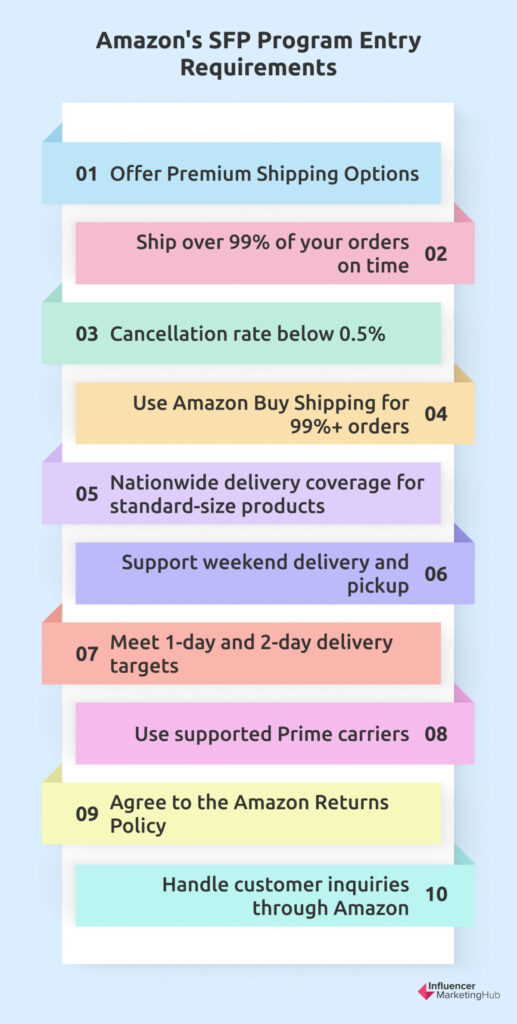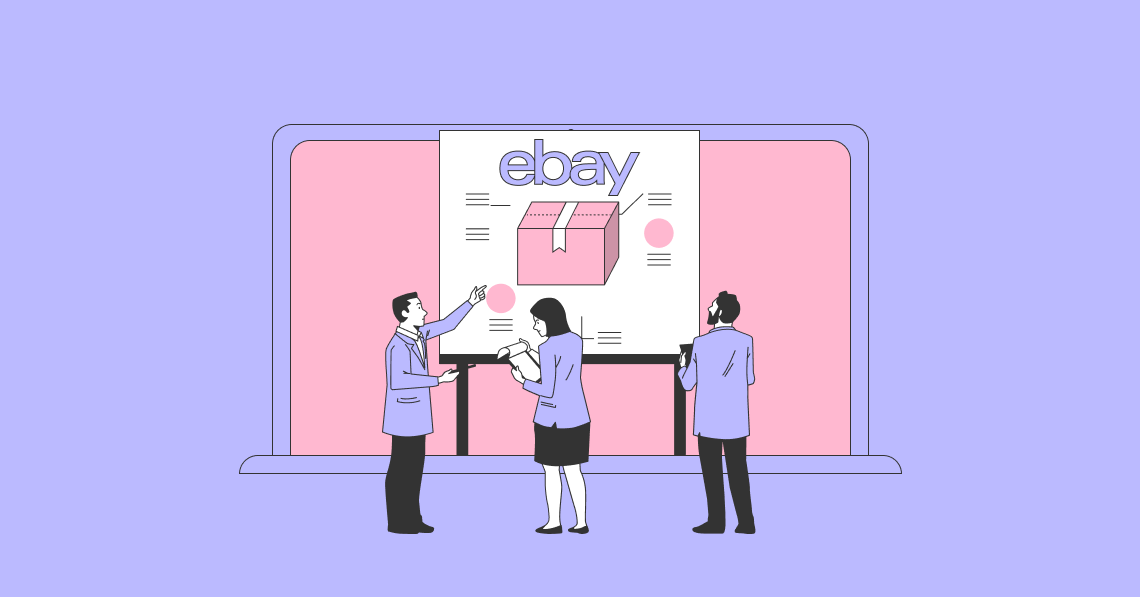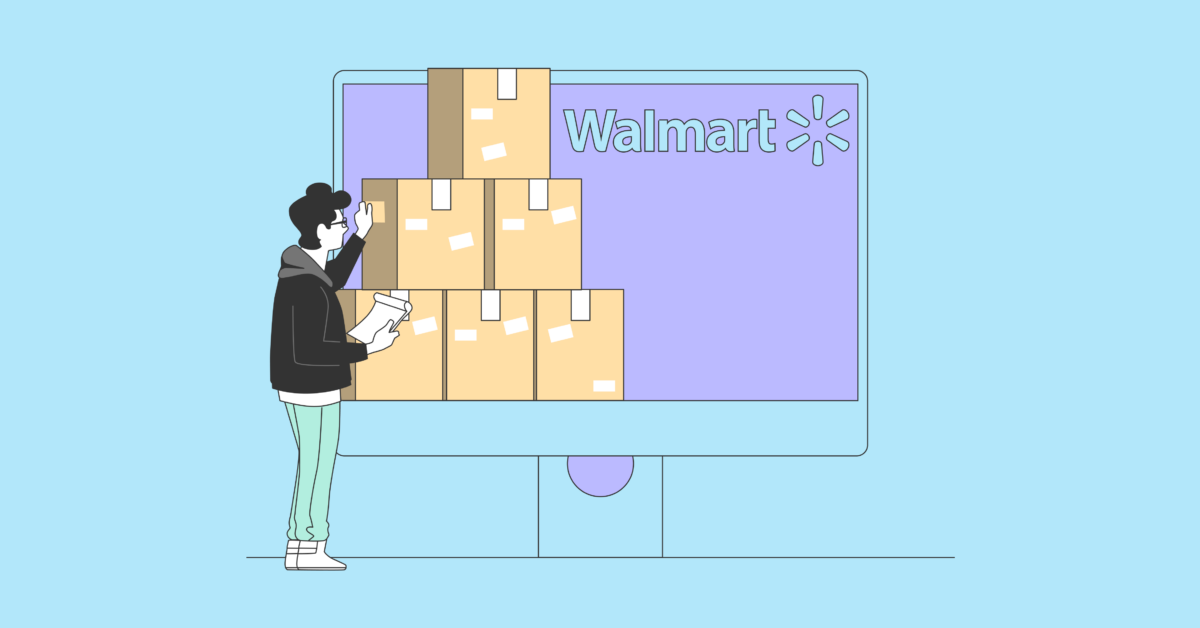Amazon Seller Fulfilled Prime (Amazon SFP) is an Amazon program that allows you to deliver directly to domestic Prime customers from your warehouse or that of a third-party specialist. You can display the Prime badge and commit to fulfilling orders with Two-Day Delivery at no additional charge for Prime customers. Amazon doesn’t leave it to chance, however, that you will succeed. They give you access to their preferred transportation solutions to help you meet the high bar for the Prime customer experience.
Amazon SFP Might Be Perfect for Your Business – If You Can Access It:
- What is Amazon SFP?
- Why Consider Joining Amazon SFP?
- Amazon SFP Requirements
- How Does Amazon Seller Fulfilled Prime (Amazon SFP) Differ from Fulfillment by Merchant (FBM)?
- How Does Amazon Seller Fulfilled Prime (Amazon SFP) Differ from Fulfillment by Amazon (FBA)?
- Amazon SFP is a Hybrid Between FBM and FBA
- Meeting Amazon’s Requirements
- Reasons to Consider Seller-Fulfilled Prime (Amazon SFP)
- Reasons Not to Apply for Amazon SFP’s Waitlist
What is Amazon SFP?
Amazon SFP is a method by which Prime sellers can fulfill orders (or work with a third-party fulfillment company to do necessary tasks for them), as long as they meet stringent requirements, particularly regarding delivery schedules. This differs from the usual situation, where if you don’t use Amazon to fulfill your orders, you can’t add the Amazon Prime logo to your listings.
If you’re enrolled in Amazon SFP you take responsibility for storing inventory in your (or your partners’) warehouses, handling most stages of fulfillment, but you don’t take care of customer feedback. As a result, you face fewer restrictions than if you left fulfillment to Amazon, although you do have to ensure that your logistics and service meet Amazon’s expectations. And, of course, Amazon sets rigid requirements for sellers to be allowed to join the scheme, as they don’t want to tarnish the reputation of Prime.
Currently, you can’t just opt to sign up to Amazon SFP, however. Amazon is not accepting new registrations at this time, and they ask you to join a waitlist.
Why Consider Joining Amazon SFP?
You may notice that some sellers have the coveted Prime badge on their Amazon listings. This is arguably the most important benefit of joining Amazon SFP if you aren’t already using Fulfillment by Amazon (FBA) to manage your fulfillment needs.

You will notice in the above image how all the printers have the Prime logo beside them. They aren’t all sold by the same supplier, and indeed some are sold by Amazon itself, but all the external sellers belong to either Amazon SFP (or possibly FBA if they are small) and can display the badge on their listings.
The badge can be a real boost to sales, with many Amazon Prime members choosing items with the badge over those without. And why would you want to miss out on appealing to Amazon Prime members? Amazon has over 200 million Prime members and is available in 22 countries. It is particularly popular with those living in the US, where nearly 150 million Prime members reside (74% of all Amazon Prime subscriptions). Sales during Prime Day on Amazon reached $11.79 billion in 2021.
Having an Amazon Prime badge means that your product is much more likely to be listed as the featured offer for a product, making it the default purchase option when someone clicks “Add to Basket”.
Apart from gaining access to the Amazon Prime badge (without having high FBA fees), there are other benefits of acceptance into Amazon Seller Fulfilled Prime. These include increased visibility for your inventory, particularly when compared to Fulfillment by Amazon (FBA), where you leave all fulfillment matters to Amazon.
If you’re carrying our fulfillment yourself, you can use your own branding on your packaging. Whereas if you leave it to Amazon, they will deliver your product in boxes emblazoned with Amazon (and Prime) logos.
Some merchants include Amazon as part of a multichannel selling strategy. FBA limits your ability to manage your Amazon sales alongside your sales from other channels. Yet, traditional Fulfillment by Merchant (FBM) takes away some of the benefits of selling on Amazon in the first place (like access to the Amazon Prime logo). With SFP you gain all the advantages and cost savings of handling all your channels together yet can still appear “official” to potential customers on the Amazon platform.
Amazon SFP Requirements
Amazon is picky about who it lets display its Amazon Prime badge. This is undoubtedly why they have limited membership in the Amazon SFP program and created a waitlist. However, even when there was a freer entry to the program they set stringent requirements, which you would have to agree to before they would accept your application.
Amazon includes the following as requirements for entry into the SFP program once they reopen it. You must assure them that you can:

- Offer Premium Shipping Options
- Ship over 99% of your orders on time
- Have an order cancellation rate of less than 0.5%
- Use Amazon Buy Shipping Services for at least 99% of orders
- Have nationwide delivery coverage for all standard-size products
- Use ship methods that support weekend delivery and pick up (Saturday or Sunday)
- Meet targets for 1-day and 2-day delivery promises
- Deliver orders with supported Seller Fulfilled Prime carriers
- Agree to the Amazon Returns Policy
- Allow for all customer service inquiries to be dealt with by Amazon
The last requirement makes Amazon SFP different from Fulfillment by Merchant (FBM) – typically you have to deal with your own customer service if you don’t opt for Fulfillment by Amazon (FBA).
How Does Amazon Seller Fulfilled Prime (Amazon SFP) Differ from Fulfillment by Merchant (FBM)?
Most sellers who opt out of having Amazon fulfill their orders use Fulfillment by Merchant (FBM), which Amazon confusingly calls Merchant Fulfilled Network (MFN). When selling on Amazon, you can use the acronyms FBM and MFN interchangeably.
With FBM, sellers list their products in Amazon stores but manage all storage, shipping, and customer support independently. To a large extent, Amazon SFP works the same (with more stringent requirements), although Amazon takes control of customer service, and you must use their approved shipping companies. With FBM, the seller (merchant) handles all aspects of a sale, including inventory management and shipping.
SFP sellers handle inventory storage and management, but they must purchase shipping through Amazon.
How Does Amazon Seller Fulfilled Prime (Amazon SFP) Differ from Fulfillment by Amazon (FBA)?
FBA is very different from FBM. Here, you rely on Amazon’s warehouses to fill your orders. You source your products, ship them to Amazon, and rely on Amazon to do everything past this point.
As such, clients of FBA meet most of the requirements of Amazon SFP. Amazon can easily ensure that your products meet Amazon Prime delivery schedules, as they take charge of your delivery themselves. Also, if you use FBA, you delegate your customer service activities to Amazon. If an Amazon Prime customer wants to buy your product, they can do so, and receive the item within two days, just as if they had brought a product from Amazon itself. And, in most situations, if you use FBA, you can include the Amazon Prime badge on your listings.
Amazon effectively takes on all the work required of SFP merchants when you opt for FBA.
However, if you believe that you can take on the onerous requirements of SFP, you will probably find it cheaper overall than signing up for FBA. And Amazon SFP gives you more control over your inventory (although not as much as SFP). You may be able to feature the Amazon Prime badge on your listings when using the FBA model, but you relinquish much control over your products when you do.
Amazon SFP is a Hybrid Between FBM and FBA
When it comes to fulfillment on Amazon there is a clear progression, and each seller has to decide where they feel most comfortable positioning their operations.
At one extreme you have Fulfillment by Amazon (FBA), where you pay to have Amazon take on virtually every aspect of your selling on the platform, apart from sourcing inventory and marketing.
At the other extreme, you have Fulfillment by Merchant (FBM), which is designed for experienced merchants wanting flexibility and the ability to control their sales on Amazon. Sellers have a lot of power with FBM, but things can go badly wrong if they don’t know what they’re doing.
Amazon SFP is a hybrid between FBM and FBA. You still have a lot of flexibility when storing inventory and fulfilling orders, but you need to meet stringent requirements, particularly concerning storing your stock and having to leave customer service and shipping options to Amazon.
Meeting Amazon’s Requirements
If you’re a new or small seller, Amazon’s list of seller requirements to join the SFP program may appear daunting. Some of them are noticeably different from other Amazon requirements.
One is the requirement to offer nationwide delivery coverage for all standard-size products – obviously, the relevance of this will depend on the country in which you sell. But remember that the bulk of Amazon Prime members are located in the USA and purchase from the original Amazon.com store.
Also, note that there is no requirement to offer nationwide delivery coverage for oversized products, making the requirements potentially less stringent should you sell mainly oversized products. Allied with this, sellers of oversized products face less stringent targets for 1-day and 2-day delivery promises.
Amazon requires weekend fulfillment for SFP members. You will need to find a way to meet this requirement or use a partner that can.
Overall, however, unless you have already built a sturdy fulfillment network, you will probably find it easier to outsource your fulfillment to a specialist third party if you want to meet Amazon’s requirements.
Reasons to Consider Seller-Fulfilled Prime (Amazon SFP)
So, is Amazon SFP a viable option for your business? With strict entry requirements (and apparently with an interminable wait), why would you even consider applying for membership?
Benefit WHY? Coveted Amazon Prime Logo Boosts product confidence and appeal, especially to Amazon Prime members who are more inclined to purchase. Establish an Independent Brand Like FBM, sellers have control over packaging and promotion but with added visibility. Maintain Brand Control More say over how products appear on Amazon and their packaging, avoiding generic Amazon boxes. Potential Easier Management than FBA Despite strict SFP rules, using external specialist fulfillment firms may make it easier than managing FBA. Customer Service Managed by Amazon Sellers don't have to handle customer service inquiries, freeing up time and resources.
For a start, there is that coveted Amazon Prime logo. Having that logo appear beside your product gives a clear indication of confidence in your product, making it appear as solid as Amazon itself to many browsers, particularly those who have signed up for Amazon Prime. And of course, shoppers who have committed to an Amazon Prime subscription are more likely to make online purchases than the ordinary person searching Amazon.
Also, like Fulfillment by Merchant (FBM), you have more of a chance to establish an independent brand, as you are responsible for the packaging and promotion. However, you no longer need to worry about customer service and gain increased visibility compared to FBM sellers.
Unlike Fulfillment by Amazon (FBA), get can keep control of your brand. You have far more say over how your products look on Amazon, and perhaps more importantly, how they look when they arrive at the customer’s address. You can brand all parts of your product’s packaging, rather than having it delivered to customers in a generic Amazon box.
And FBA doesn’t mean that you face no Amazon rules. You still have many requirements to meet before they accept your inventory in their warehouses. Despite the strict rules of Amazon SFP, some may still find it easier to manage than FBA, especially if they use an external specialist fulfillment firm to ensure that they meet Amazon’s shipping requirements.
Reasons Not to Apply for Amazon SFP’s Waitlist
You need to consider both how important it is to you to have the Amazon Prime logo on your listings versus your need to have control over the fulfillment of your orders.
Cons of Joining Amazon SFP
Drawback WHY? Stringent Entry Requirements The waitlist is long and gaining acceptance can be challenging. Balancing Prime Logo vs. Fulfillment Control Sellers need to weigh the importance of the Amazon Prime logo against their desire for fulfillment control. Benefits Accessible through Basic FBA Sellers who are content with paying for Amazon's fulfillment and adhering to FBA rules can still cater to Amazon Prime members without SFP. Alternative Option for Large Vendors Large vendors can sell directly to Amazon through Vendor Central, bypassing fulfillment issues altogether and automatically gaining the Prime logo.
If you are happy to pay Amazon to fulfill your orders and prepared to meet some additional requirements over basic FBA rules, you can still access the benefits of selling to Amazon Prime members. In that case, there is little point in going through all the challenges to gain acceptance into Seller Fulfilled Prime.
Of course, there is a third group of traders whose products sell on Amazon. If you’re one of those (generally large) vendors who sell your products to Amazon (rather than on Amazon), then you don’t have to worry about any of these fulfillment issues. You simply keep selling stock to Amazon, meeting any of their orders that come your way. In most cases Amazon will automatically place the Amazon Prime logo on these items, to encourage increased sales of (their) inventory. However, Vendor Central is invitation-only – you must be recruited by Amazon to choose that trading option.
Wrapping Things Up
Unfortunately, the greatest hurdle to becoming an Amazon SFP member may be the waitlist. Amazon doesn’t appear to be in a hurry to shorten the waitlist, and even if you meet all the other Amazon requirements, you may find yourself languishing on the waitlist for some time yet, which must be infuriating if most of your competitors have already been accepted into the program.


